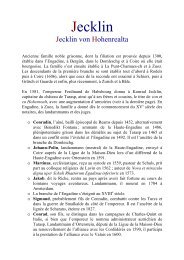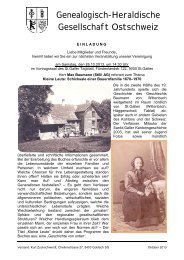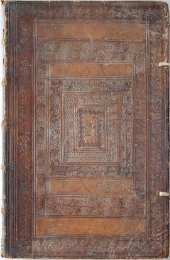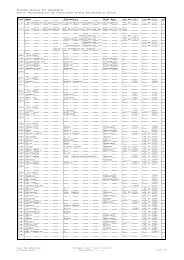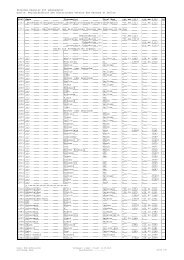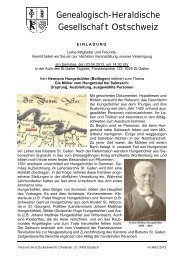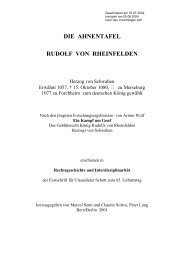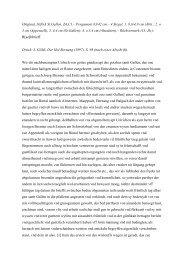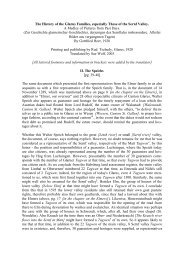The History of the Glarus Families, especially Those of the Sernf ...
The History of the Glarus Families, especially Those of the Sernf ...
The History of the Glarus Families, especially Those of the Sernf ...
You also want an ePaper? Increase the reach of your titles
YUMPU automatically turns print PDFs into web optimized ePapers that Google loves.
<strong>The</strong> <strong>History</strong> <strong>of</strong> <strong>the</strong> <strong>Glarus</strong> <strong>Families</strong>, <strong>especially</strong> <strong>Those</strong> <strong>of</strong> <strong>the</strong> <strong>Sernf</strong> Valley.<br />
A Medley <strong>of</strong> Pictures from Past Days.<br />
(Zur Geschichte glarnerischer Geschlechter, derjenigen des <strong>Sernf</strong>tales insbesondere. Allerlei<br />
Bilder aus vergangenen Tagen)<br />
By Gottfried Heer, 1920<br />
Printing and publishing by Rud. Tschudy, <strong>Glarus</strong>, 1920<br />
Translated by Sue Wolf<br />
[All lettered footnotes and information in brackets were added by <strong>the</strong> translator]<br />
XXIV. <strong>The</strong> Heftis<br />
[pg. 144-145]<br />
"On 16 November 1634," as <strong>the</strong> church register <strong>of</strong> that place reported, <strong>the</strong> Elm commune<br />
"elected new leaders: 1. church steward: Kaspar Ellmer, <strong>of</strong> <strong>the</strong> council, instead <strong>of</strong> Hans Ulrich<br />
Ellmer. 2. charity <strong>of</strong>ficial: Heinrich Elmer, beyond <strong>the</strong> brook a , instead <strong>of</strong> Jacob Gyger. 3.<br />
Tagwen b <strong>of</strong>ficial; Samuel Höffti, instead <strong>of</strong> Jochum Sollman."<br />
Samuel Höffti, who was <strong>the</strong> newly appointed Tagwen <strong>of</strong>ficial (president and administrator),<br />
was <strong>the</strong> one who transplanted <strong>the</strong> Hefti family from Hätzingen to Elm. Married to an Anna<br />
Speich, he had brought a first child, Margretha, to baptism in <strong>the</strong> Elm church in 1632. 1 <strong>The</strong><br />
godparents which were named on this occasion (Magdalena Erni from Zürich and Heinrich<br />
Erni, canon [<strong>of</strong> <strong>the</strong> Zürich Ca<strong>the</strong>dral] and Sacred Scriptures <strong>the</strong>ology pr<strong>of</strong>essor) create <strong>the</strong><br />
impression that Samuel Höffti belonged to a prominent family. Fur<strong>the</strong>rmore, that may also<br />
have recommended him to <strong>the</strong> Elmers for his promotion to Tagwen <strong>of</strong>ficial. Obviously, he<br />
had also previously purchased <strong>the</strong> Elm Tagwen rights.<br />
In 1742 Elm elected a Niklaus Hefti for its representative to <strong>the</strong> council. In <strong>the</strong> 1876 cantonal<br />
tax rolls <strong>the</strong> Heftis from Elm are reported on with 8 taxpayers and a property <strong>of</strong> 27,000 Fr. On<br />
<strong>the</strong> o<strong>the</strong>r hand, <strong>the</strong>y have not forgotten <strong>the</strong>ir origin from <strong>the</strong> Great [<strong>Sernf</strong>] Valley, but, from<br />
time to time, have renewed <strong>the</strong>ir Tagwen rights in Hätzingen.<br />
Besides in Elm, <strong>the</strong> Heftis in 1876 were represented in Luchsingen with 79 head-taxpayers, in<br />
Hätzingen with 69, in Schwanden with 43, in Ennenda with 33, in Haslen with 22, in Leuggelbach<br />
with 21, in <strong>Glarus</strong> with 11, and in Diesbach with 7; fur<strong>the</strong>rmore, 18 additional Heftis<br />
were found in 10 o<strong>the</strong>r communes.<br />
With 311 head-taxpayers, <strong>the</strong>y were <strong>the</strong> most numerous family <strong>of</strong> <strong>the</strong> canton. (As <strong>the</strong> second,<br />
<strong>the</strong> Zweifels, with 276 head-taxpayers, and as <strong>the</strong> third, <strong>the</strong> Jennis with 250.) However, I have<br />
already given a detailed account <strong>of</strong> <strong>the</strong> Hefti family in No. 15 <strong>of</strong> <strong>the</strong> "Historical Yearbook",<br />
pg. 75-90 (also a shorter addendum in No. 26, pg. 106-108). For this reason, I mention here<br />
merely that, according to J. J. Kubli-Müller's information, <strong>the</strong> Amden [Canton St. Gallen] anniversary<br />
book for <strong>the</strong> 15 th and <strong>the</strong> beginning <strong>of</strong> <strong>the</strong> 16 th centuries shows various Heftis as<br />
citizens and citizenesses <strong>of</strong> Amden; thus a Hans Hefti, who was married, in his first marriage,<br />
to Margreth Büsser, and, in his second marriage, to Agatha Roner. In addition, a Jakob Hefti,<br />
who was married to Barbara Thoma, whose son, Jakob, was married to Brigitta Krämer and,<br />
in his second marriage, to Margr. Schorer; a bailiff, Hans Hefti; and a bailiff, Michael Hefti.<br />
From Amden, <strong>the</strong>n, members <strong>of</strong> <strong>the</strong> Hefti family, as followers <strong>of</strong> <strong>the</strong> "new faith", could have<br />
come to Hätzingen 2 , where we met <strong>the</strong>m in 1542, as a result <strong>of</strong> <strong>the</strong> Reformation, as <strong>the</strong> reac-
tion set in [against <strong>the</strong> "new faith"] in <strong>the</strong> Gaster [<strong>the</strong> Canton St. Gallen district where Amden<br />
is located, which remained Catholic] after <strong>the</strong> second Kappeler war [1531].<br />
However, an Italian document, which has already been <strong>of</strong>fered for purchase for 40 years,<br />
which traces <strong>the</strong> history <strong>of</strong> <strong>the</strong> Heftis back to <strong>the</strong> time <strong>of</strong> Kaiser Friedrich Barbarossa [Holy<br />
Roman Emperor, 1152-1190] and to Hungary, and allocates high military positions to <strong>the</strong>m,<br />
may be considered as a fabrication for speculative purposes.<br />
a Field name: people with identical names were differentiated by adding <strong>the</strong>ir occupation or a descriptive term<br />
for <strong>the</strong> area where <strong>the</strong>y lived [SW]<br />
b Tagwen – an ancient term, from at least <strong>the</strong> 6th century A.D., which is still used today in Canton <strong>Glarus</strong> to<br />
denote <strong>the</strong> commune <strong>of</strong> <strong>the</strong> citizens, i.e. those who have inherited or purchased <strong>the</strong> Tagwen rights (this may only<br />
partially coincide with <strong>the</strong> political commune). It is derived from Tage Wann, meaning <strong>the</strong> work someone could<br />
perform in one day in <strong>the</strong> commonly-held fields, pastures and forests. Over <strong>the</strong> years <strong>the</strong> number <strong>of</strong> Tagwen in<br />
<strong>the</strong> canton has varied considerably, with <strong>the</strong> present-day number being 29. Also its duties have changed – from<br />
jointly working on and enjoying <strong>the</strong> benefits <strong>of</strong> its common property, to administering all <strong>the</strong> commune’s public<br />
interests, to (today) administering and enjoying <strong>the</strong> benefits <strong>of</strong> its common property. [SW]<br />
1 In 1634 a second daughter, Elsbeth, followed, and, in 1637, a head <strong>of</strong> family, Samuel.<br />
2 From Hätzingen <strong>the</strong> Hefti family also went to Norway in <strong>the</strong> 18 th century, by means <strong>of</strong> Johannes Hefti (born in<br />
1730, died in 1801), who, at first from Hätzingen, carried on a timber trade to <strong>the</strong> Ne<strong>the</strong>rlands, but <strong>the</strong>n emigrated<br />
to Norway. <strong>The</strong>re he established a timber business with his sons, Thomas, Fridolin and Heinrich, and later<br />
he added on a bank to it. Descendants <strong>of</strong> this Hefti still live today in Christiania. <strong>The</strong>y have long since become<br />
Norwegians; none<strong>the</strong>less, <strong>the</strong>y have not completely forgotten <strong>the</strong>ir Hätzingen origins (one <strong>of</strong> <strong>the</strong>m requested a<br />
Hefti family tree from me about 30 years ago, which request I, however, could not satis fy at <strong>the</strong> time because <strong>of</strong><br />
o<strong>the</strong>r work).



